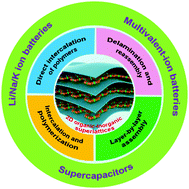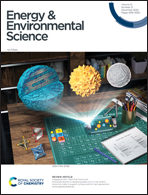Two-dimensional organic–inorganic superlattice-like heterostructures for energy storage applications
Abstract
Two-dimensional (2D) superlattices, assembled from vertically stacked inorganic 2D nanosheets, are a new class of artificial 2D materials of significant scientific and technological importance. The incorporation of an infinite number of organic molecules within these systems further provides unlimited possibilities for the design and synthesis of 2D organic–inorganic hybrid superlattices with predictable functionalities. Herein, the recent research progress in 2D organic–inorganic hybrid superlattices is summarized. Many facile strategies have been developed for the fabrication of 2D organic–inorganic hybrid superlattices, in which continuous organic layers are intercalated in the interlayer galleries of inorganic 2D nanosheets at an atomic/molecular scale. The advantages of these 2D superlattices are discussed for some typical energy storage applications, such as supercapacitors, lithium/sodium/potassium ion batteries, and multivalent-ion rechargeable batteries. The challenges and perspectives for future research are also outlined.



 Please wait while we load your content...
Please wait while we load your content...